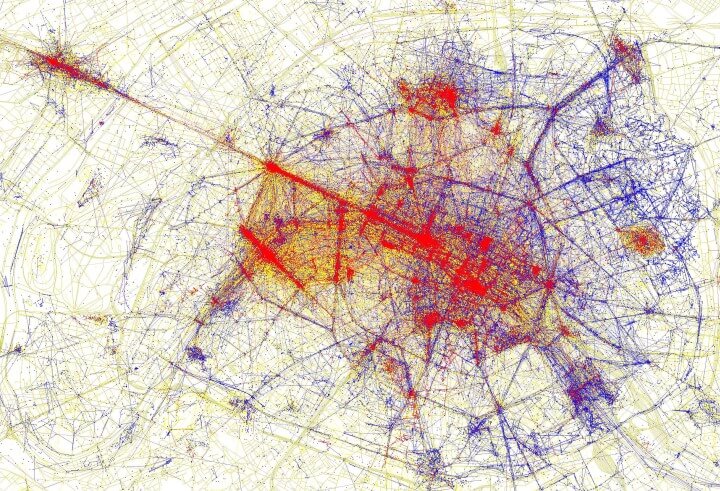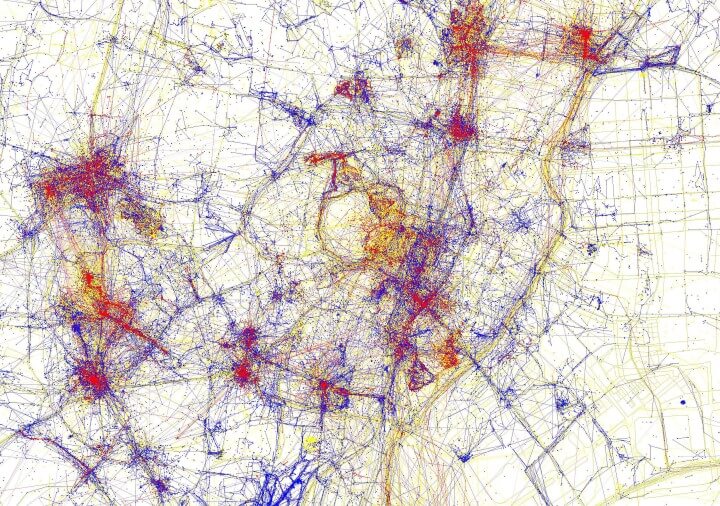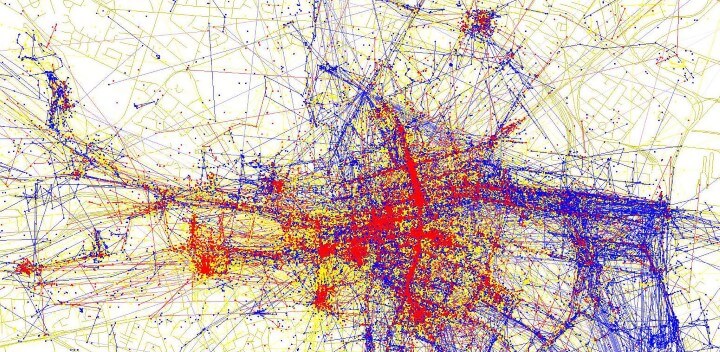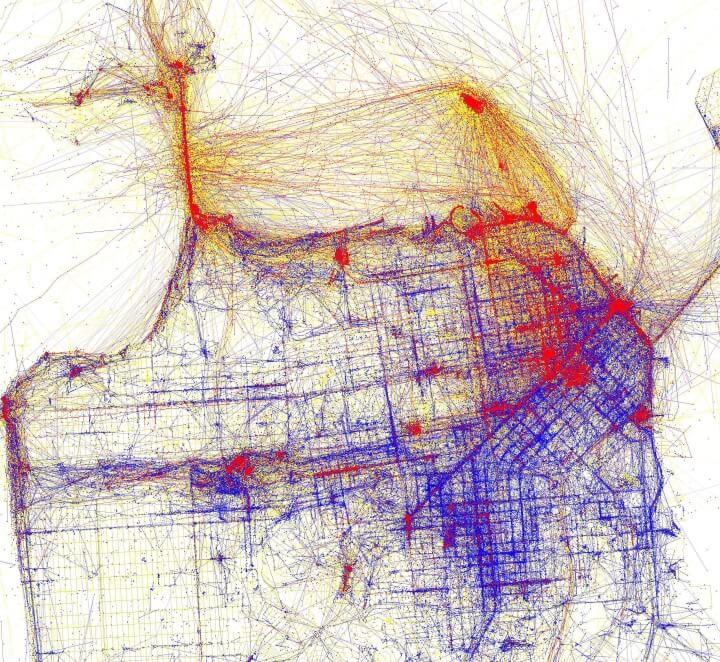[Most Recent Entries] [Calendar View]
Wednesday, June 5th, 2019
| Time | Event |
| 8:00a | 136 Maps Reveal Where Tourists & Locals Take Photos in Major Cities Across the Globe
How to tell the tourists in a city from the locals? Potentially reliable indicators include the language they speak, the terms they use, the way they dress, the way they walk, and whether they're standing in the middle of the sidewalk squinting at a map. But few factors draw the line between tourist and local more starkly than where they go and don't go: no matter the city, one will sooner or later hear talk of places locals know that tourists don't, places locals don't go because tourists do know about them, places tourists go when they want to act like locals, places locals go when they want to act like tourists, and so on.
In his project "Tourists and Locals," Eric Fischer has found one way of quantifying this great divide: where do the members of each group take the photos they upload to the internet? You can view the results in 136 different city maps or explore a whole world map, both of which use the same color coding: "The red bits indicate photos taken by tourists," says Brilliant Maps, "while the blue bits indicate photos taken by locals and the yellow bits might be either." Using "MapBox and Twitter data from Gnip to create the maps," Fischer defined locals as "those who tweeted from the same location for at least a month" and tourists as "those who were considered local in another city but were tweeting in a different location."
Here, from the top of the post down, we have Fischer's maps of Paris, Tokyo, Dublin, and San Francisco, all cities with varying degrees of overlap between the realm of the local and that of the tourist. Parisian attractions like the Parc de Belleville and the Bassin de la Villette show a relatively healthy tourist-local balance, whereas outsiders dominate in places like La Défense with its highly photographable skyscrapers, and of course the Louvre (to say nothing of the red-saturated Versailles, not pictured in this segment of the map). Compare that with Tokyo, which of course has world-famous spots — the quaintly historic Asakusa, the sublimely urban Shibuya Crossing — but whose form doesn't encourage quite as strict a physical separation of tourist and local.
The path a tourist takes through Dublin might overlap a great deal with the one Leopold Bloom took on June 16, 1904, but less so with the paths an average Dubliner takes in the 2010s. The Irish capital also offers a host of must-sees apart from the Ulysses tour — the Guinness Storehouse, Trinity College's Old Library, home of The Book of Kells— but visitors would do well to follow the example of Dublin's locals and get a bit more distance from the city center. They could do the same in San Francisco, a city of iconic tourist attractions on which, before the tech boom, its very survival seemed to depend. But do true travelers, as opposed to tourists, need this kind of data processing and information design to know their time would be better spent somewhere other than Fisherman's Wharf? See 136 different city maps here. via Brilliant Maps Related Content: Take a Visual Journey Through 181 Years of Street Photography (1838-2019) The Shifting Power of the World’s Largest Cities Visualized Over 4,000 Years (2050 BC-2050 AD) How Leonardo da Vinci Drew an Accurate Satellite Map of an Italian City (1502) James Joyce’s Dublin Captured in Vintage Photos from 1897 to 1904 An Online Gallery of Over 900,000 Breathtaking Photos of Historic New York City A Wonderful Archive of Historic Transit Maps: Expressive Art Meets Precise Graphic Design Based in Seoul, Colin Marshall writes and broadcasts on cities, language, and culture. His projects include the book The Stateless City: a Walk through 21st-Century Los Angeles and the video series The City in Cinema. Follow him on Twitter at @colinmarshall, on Facebook, or on Instagram. 136 Maps Reveal Where Tourists & Locals Take Photos in Major Cities Across the Globe is a post from: Open Culture. Follow us on Facebook, Twitter, and Google Plus, or get our Daily Email. And don't miss our big collections of Free Online Courses, Free Online Movies, Free eBooks, Free Audio Books, Free Foreign Language Lessons, and MOOCs. |
| 11:00a | Pulitzer Prize-Winning Author Jared Diamond Describes How the U.S. Could Become a Dictatorship in 10 Years It can happen here, and it has. By “it” I mean the enormous concentration of wealth and political power in the hands of a very few, and by “here” I mean the United States of America, a country that advertises itself as a democracy, but should rightly be referred to as an oligarchy, ruled by a wealthy elite. But the country is not a dictatorship yet. I say “yet” because that too can happen here, given the aforementioned concentration of wealth and power, the increasing tolerance for nationalism, cruelty, xenophobia, and near-constant lying, and the craven acquiescence so many of the country’s legislators—who are supposed to put a check on such things—have shown to the whims of a baldly autocratic executive. Perhaps it is only a matter of time, given the above. How much time? Maybe ten years, argues Jared Diamond, Pulitzer Prize-winning anthropologist, geographer, historian, and ecologist, and author of The Third Chimpanzee; Guns, Germs, and Steel; Collapse: How Societies Choose to Fail or Succeed; and The World Until Yesterday. In the Big Think video interview clip above, Diamond frames the problem as one of an unwillingness to compromise, using the analogy of a happy marriage. “The best you can hope for in a marriage is an agreement on 80%. If you agree on 80%, that’s fantastic.” For any two people, married or otherwise, 80% agreement seems optimistic. For an entire country, it seems almost utopian. But whatever number you want to set as a realistic goal, the U.S. has fallen far below it—at least when it comes to the way our governmental bodies work, or don’t, together. This is not a problem reducible to “both sides.” One party in particular has consistently refused to work with the other and used every dirty trick—from extreme gerrymandering to refusing to let a sitting President appoint a Supreme Court Justice—to hold power. Politics is a dirty business, you may say, and yes, it is. But—to return to Diamond’s point—a functioning democracy requires compromise. These days, congress cannot pass legislation; “legislatures are at odds with the judiciary” (Diamond cites the example of the Republican-controlled West Virginia congress impeaching the state’s entire, Democratic-majority, supreme court in 2018); state governments are suing the federal government, and vice-versa. The failure of compromise, says Diamond, is “the only problem that could precipitate the United States into the end of democracy and into a dictatorship in the next decade.” The usual historical examples can be more or less instructive on this point. But there are other, more recent, dictatorships that do not receive nearly enough attention—perhaps by design, since they have been “friendly” regimes that the U.S. helped create. Diamond describes the situation in Chile, for example, where he lived in the late 60s. When he first moved there, it had been “the most democratic country in Latin America,” a country that prided itself on its ability to compromise. But this quality was in decline, he says, and its loss led to the country’s military coup in 1973, which brought the brutal dictator Augusto Pinochet to power (with the help of the CIA and certain American economists). The new Chilean government “smashed world records for sadism and torture,” says Diamond, shocking those Chileans who believed their country was immune to the excesses of other Latin American nations that had succumbed to repressive authoritarianism. If that happens here, he argues, it will not come through a military coup, but rather through “what we see going on now”—namely restrictions on the right to vote and voter apathy. Voting is the primary solution, Diamond claims, but voting alone may not address the problem of oligarchy. When a handful of the wealthy control mass media, fund local and national political campaigns, and otherwise exert undue influence, through mass surveillance, manipulation, and the use of foreign agents, the possibility of free and fair elections may disappear, if it hasn’t already. Nonetheless, Diamond’s point deserves some serious consideration. If we want to avert dictatorship in the U.S., how can we encourage compromise—without, that is, relinquishing our most fundamental values? It's a point to ponder. Related Content: Aldous Huxley Warns Against Dictatorship in America Umberto Eco Makes a List of the 14 Common Features of Fascism Hannah Arendt on “Personal Responsibility Under Dictatorship:” Better to Suffer Than Collaborate Josh Jones is a writer and musician based in Durham, NC. Follow him at @jdmagness Pulitzer Prize-Winning Author Jared Diamond Describes How the U.S. Could Become a Dictatorship in 10 Years is a post from: Open Culture. Follow us on Facebook, Twitter, and Google Plus, or get our Daily Email. And don't miss our big collections of Free Online Courses, Free Online Movies, Free eBooks, Free Audio Books, Free Foreign Language Lessons, and MOOCs. |
| 4:50p | See the Very First Solar Eclipse Captured on Film: A Magical Moment in Science and Filmmaking (1900) The “conquest of space,” so to speak—the human understanding of and travel to the cosmos—has come about through a succession of great scientific minds, as well as some of the most interesting and accomplished people all around. We never seem to tire of learning about their devotion to mathematics, physics, medicine, and scientific discovery writ as large as possible. But sometimes the conquest of space has required the unique talents of magicians. From the ancient mages who excited human imagination about the stars for thousands of years, to alchemists like Isaac Newton and beyond. Witness the strange career of Marvel Whiteside Parsons, better known as Jack Parsons: sci-fi fanatic, occultist, disciple of Aleister Crowley, and onetime magical partner of L. Ron Hubbard. Parsons is most famous for founding the Jet Propulsion Laboratory, the research center that powers NASA. Then we have magician Nevil Maskelyne—son of magician John Nevil Maskelyne, and possible descendent, so he said, of the fifth British Royal Astronomer, “also named Nevil Maskelyne,” writes Jason Daley at Smithsonian. Maskelyne the very much younger documented the first total solar eclipse ever captured on film. Granted, he was a stage magician, not a follower of “The Great Beast 666.” Maskelyne's interest in showmanship and spectacle drew him not to sex magic but to filmmaking and astronomy, interests he combined when he made the first film ever of a total solar eclipse. Nowadays, millions of people have the means to make such a film in their pocket, provided they have a good view of the infrequent cosmic event (and do not ever look at it directly). In 1900, when Maskelyne undertook the challenge, filmmaking was just emerging from infancy into toddlerhood. The Lumière brothers, often credited as the first filmmakers, had held their first public screening only five years earlier. They called their early productions actualités, essentially "reality films." Some of these, like the legendary L'arrivée d'un train en gare de La Ciotat, famously shocked and terrified audiences out of their seats. In 1900, film was still a kind of magic, and “like magic,” says Bryony Dixon, curator at the British Film Institute (BFI), film “combines both art and science.” The story of Maskelyne’s achievement is “a story about magic.” Maskelyne’s love for film inspired in him a passion for astronomy as well, and he eventually became a fellow of the Royal Astronomical Society. Unfortunately, his first cinematic contribution to the field disappeared, never to be seen again. Two years before he shot the footage above from the ground in North Carolina on May 28, 1900, on a venture funded by the British Astronomical Association, Maskelyne traveled to India to document a similar event. The film cannister was stolen on his return trip home But he had learned what he needed to, having designed “a special telescopic adapter for a movie camera,” just as he and his father had earlier improved upon the film projector by building their own. Maskelyne had his spectacle. He showed the film in his theater, and the Royal Astronomical Society ensured that we could see it almost 120 years later by archiving a minute of the footage. Thanks to a partnership between the British Film Institute and the RAS, the film has been restored, digitized in 4K resolution, and made freely available online as part of a trove of Victorian-era films” just released by the BFI. While thousands, maybe millions, of different moving images of 2017's solar eclipse exist on social media accounts, of this event 120 years ago there has existed only one. Now that brief moment in time can reach millions of people in an instant, and exist in an infinite number of perfect copies, a phenomenon that might have seemed in 1900 like an advanced form of magic. via Smithsonian Related Content: Moons, Moons, They’re Everywhere. The Unexpected Shadows of the Solar Eclipse Last Night’s Solar Eclipse in a 60-Second, 700-Picture Timelapse Video Solar Eclipse Seen From Outer Space Josh Jones is a writer and musician based in Durham, NC. Follow him at @jdmagness See the Very First Solar Eclipse Captured on Film: A Magical Moment in Science and Filmmaking (1900) is a post from: Open Culture. Follow us on Facebook, Twitter, and Google Plus, or get our Daily Email. And don't miss our big collections of Free Online Courses, Free Online Movies, Free eBooks, Free Audio Books, Free Foreign Language Lessons, and MOOCs. |
| << Previous Day |
2019/06/05 [Calendar] |
Next Day >> |






